Knowing how to treat spider bites and recognizing poisonous spiders is important, and this article reviews the most common poisonous spiders and provides an overview of spider bite treatments.
Before we go around destroying all spiders, remember that they help balance ecosystems and keep nuisance insect populations under control.
Though most spiders are harmless, some have fangs large enough to cause irritation and poisons strong enough to send you to the emergency room.
Table of contents
What Types of Spiders You Need to Be Aware of?
There aren’t too many spiders in the US that can put you in the hospital, but I’m going to take you through the main ones that may put you there.
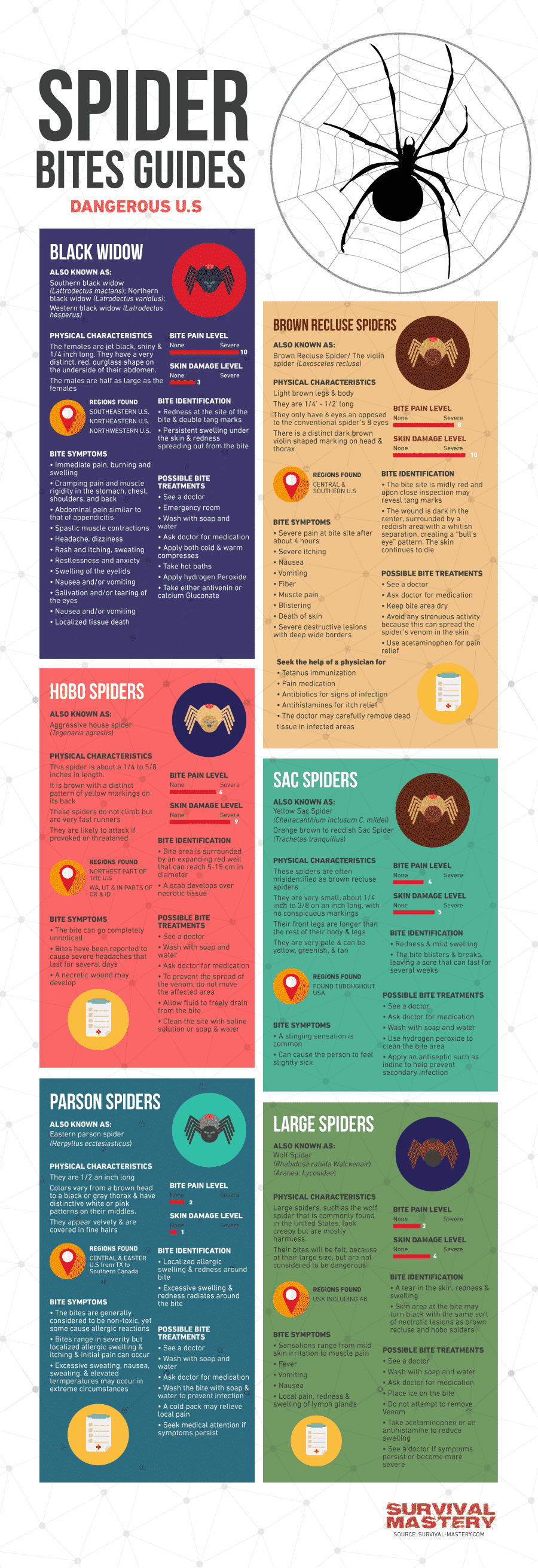
Knowing the main ones to watch out for will put your mind at ease and help you identify those that do need to be eliminated.
Brown Recluse
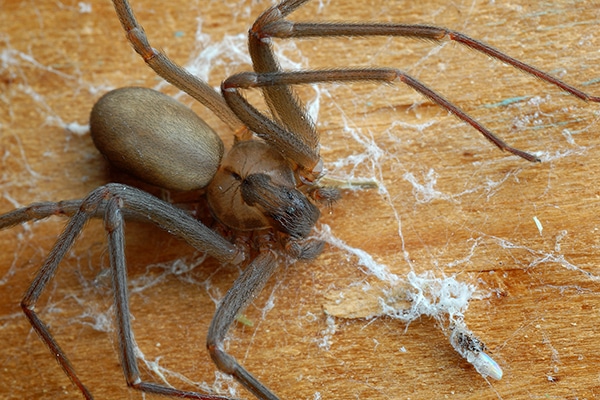
The Brown Recluse is a well-known spider in the US because of its widespread territory. These spiders are not known to be aggressive, but their bites pose a serious threat to humans.
Symptoms include:
- Irritation and necrosis in the bitten tissue, sometimes leading to amputation
- Fever
- Nausea
- Chills
- If left untreated, death
Brown Recluse bites are incredibly painful. Spider bite treatment includes seeking medical treatment immediately if you suspect you’ve been bitten (it will be obvious).
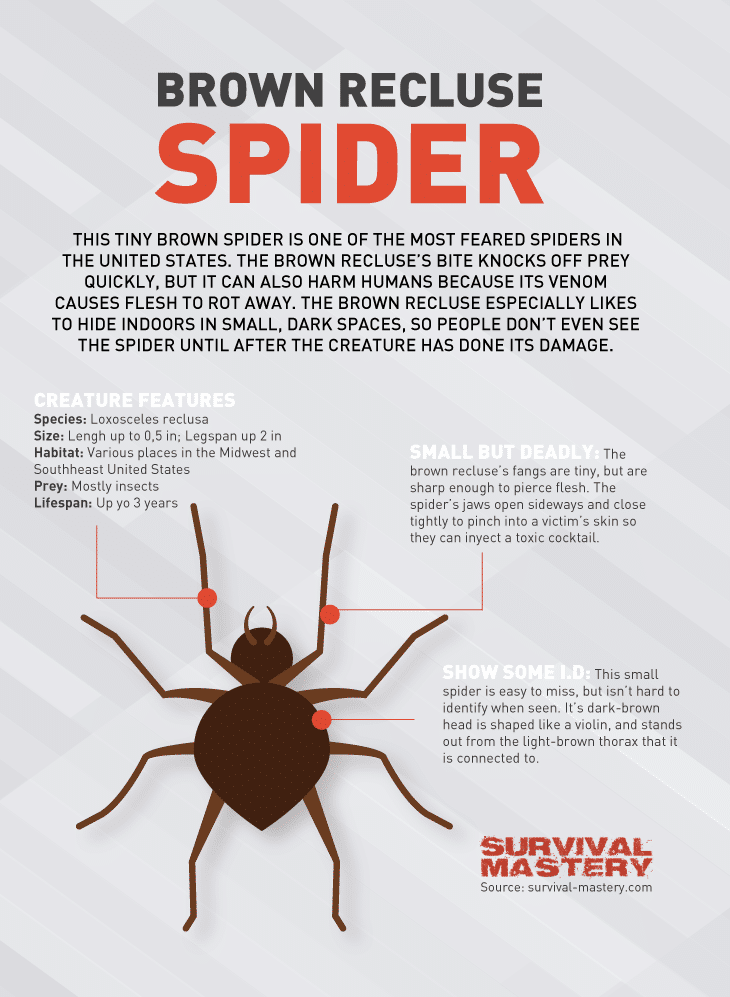
To properly identify these spiders, look for a black violin-shaped mark on its abdomen, with the neck pointing toward the end of the spider.
They’re often found in cool, shady areas, like closets, garages, and woodpiles. If you see one, be sure to eradicate them as quickly as possible.
Black Widow
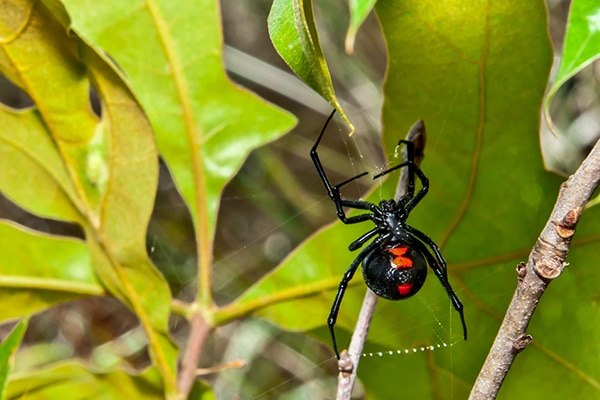
This spider is very well known, and minimal introduction is needed for its trademark characteristics. Their large, black, glossy abdomens and bright red hourglass shape are unmistakable, though some morphological differences occur due to their widespread distribution.
Black widows are found across the US, from Canada to Mexico, and tend to favor dark, dry, sheltered areas like the brown recluses. Keep an eye out for them in outhouses, dense brush, and sheds.
Their bites contain a poison that acts as a swift neurotoxin
Symptoms include:
- Intense pain and swelling at the bite site
- Muscle cramps
- Chills and/or fever
- Nausea and vomiting
- Severe aches and pains
- High blood pressure
- If untreated, death
Symptoms from black widow bites progress rapidly, with the severe ones often appearing within 30-60 minutes.
There is good news for this spider bite treatment: a very reliable antivenom was produced in 1956 and made readily available, so there are very few fatalities from this bite in modern times.
Hobo Spider
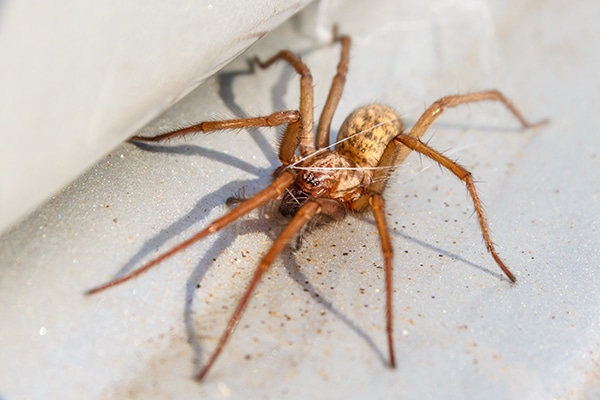
Another common spider in North America, the hobo spider, is typically found near ground level in sheltered areas, usually bringing them to human habitations.
They’re primarily found in the western United States, preferring dryer climates. These spiders are notoriously aggressive, so if you see one, keep your distance. They will often bite with little provocation.
Though their bites are typically quite painless at first, over the course of the next few hours, you will develop a nasty blister as the poison spreads.
Symptoms include:
- Inflammation
- Nausea
- Fever
- Weakness
- Temporary memory loss
- Vision impairment
These spiders can be a little tricky to identify because of their common color and appearance. However, they do have some tell-tale chevron-like markings on their abdomens – just don’t get too close to verify their identity.
As with all spider bite treatments, you should seek medical attention right away.
Yellow Sac Spiders
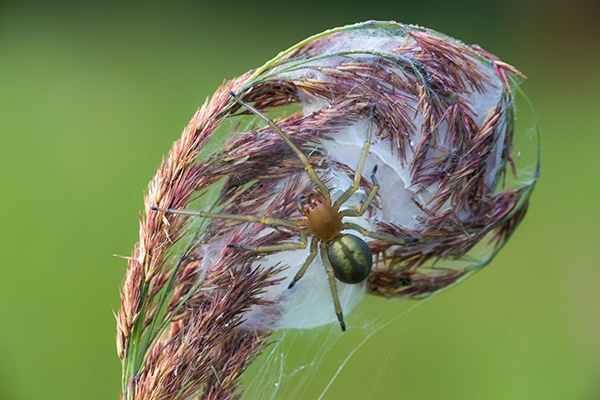
Despite being scattered across the United States, these spiders are not particularly well known from coast to coast.
They have pale yellow to pale pink bodies, though oddly enough, this color can vary depending on the prey they have recently eaten. They typically prefer the shelter of your cozy home, creating webs in snug places like curled leaves, nooks, and crevasses.
Despite their limited notoriety as a terrifying arachnid, they are believed to be the cause of most spider bites in the country. However, their preference for dark, small spaces lends them a great deal of anonymity, making it difficult to place an exact number on bite instances, as many victims never even see the guilty spider.
These spiders are mildly venomous.
Symptoms include:
- Pain and swelling
- Mild necrosis
- Edema (fluid trapped beneath the skin)
- Itchiness
Symptoms are relatively mild compared to those of other spider bites and rarely leave large scars. Just be sure to treat the wound quickly and see a doctor to avoid unnecessary pain or the possibility of an infection.
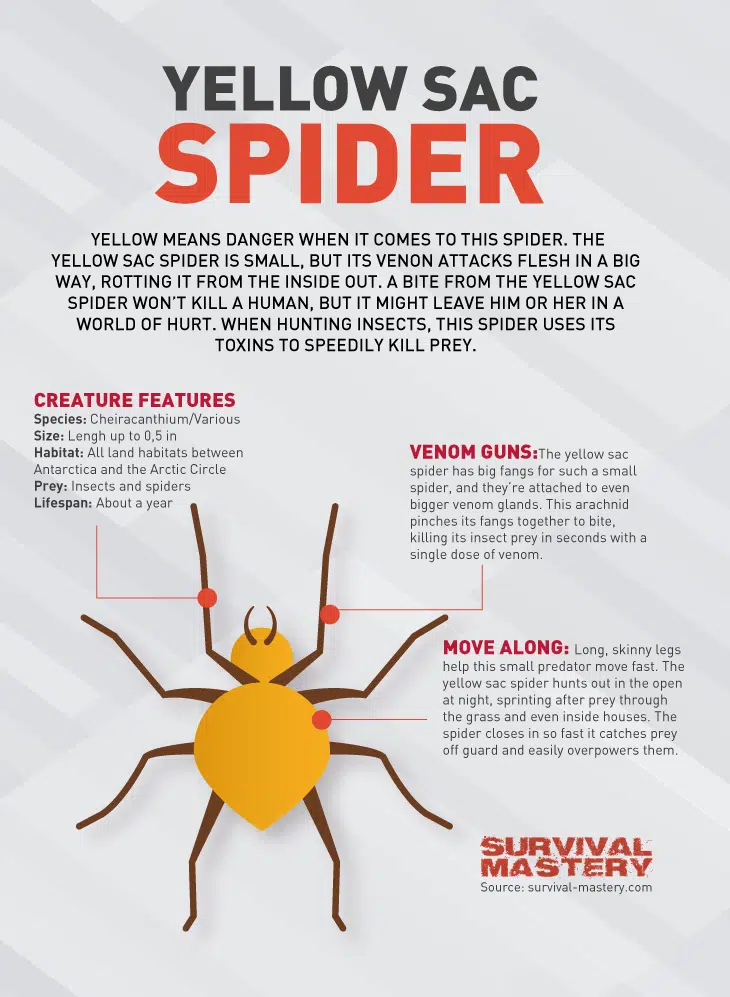
Emergency Spider Bite Treatment (Before Hospital)
There’s no doubt that the best thing to do when you receive a spider bite is to seek professional medical attention, but there may be situations where you can’t have access to a doctor.
In a pinch, you can do some initial things to manage pain and swelling and slow the spread of poison before it causes too much damage.
- Locate the wound and clean it well with antiseptic solution. You want to kill any bacteria in the bite that could cause an infection.
- Use rubbing alcohol or hydrogen peroxide, and flush the wound.
- Apply a topical antibiotic ointment and wound dressing if needed.
- If you’re experiencing swelling and pain take Ibuprofen or Tylenol for relief, but make sure you let your doctor know.
- Benzocaine or lidocaine spray can help temporarily numb the area and relieve pain if it’s too intense.
- Apply a cool compress to reduce swelling, but keep the wound sterile.
- If the bite is on a limb, elevate the extremity to control blood pressure.
Spider bite treatments may require many items usually found in a first aid kit, so carry one on all your trips. You can create your own kit or purchase one from a company like MyMedic that specializes in first aid kits.
What NOT to do with a Spider Bite
There are a few things you don’t want to do when you have a spider bite. These can exacerbate the situation, facilitating swelling and the spread of venom.
- High Activity. As you work up a sweat, your heart pumps faster, elevating your blood pressure and circulating poison through your body. Sit tight and let someone else take care of you.
- Avoid tourniquets. Many people think they should apply one in the hopes of helping to isolate the poison. Don’t do this as it can make things worse by limiting blood flow, causing weakness, and increasing pressure.
- Removing the poison. Attempting to remove the poison with suction devices, or even by cutting out the affected tissue, can not only cause further damage and infection but can even spread the poison to the person trying to help.
- Steroid creams. While antibiotic creams can definitely help treat a spider bite, make sure that you’re not using any steroid creams, facilitating a faster spread of infection.
- Heat. This will only create more swelling, increase blood pressure, and facilitate the spread of poison.
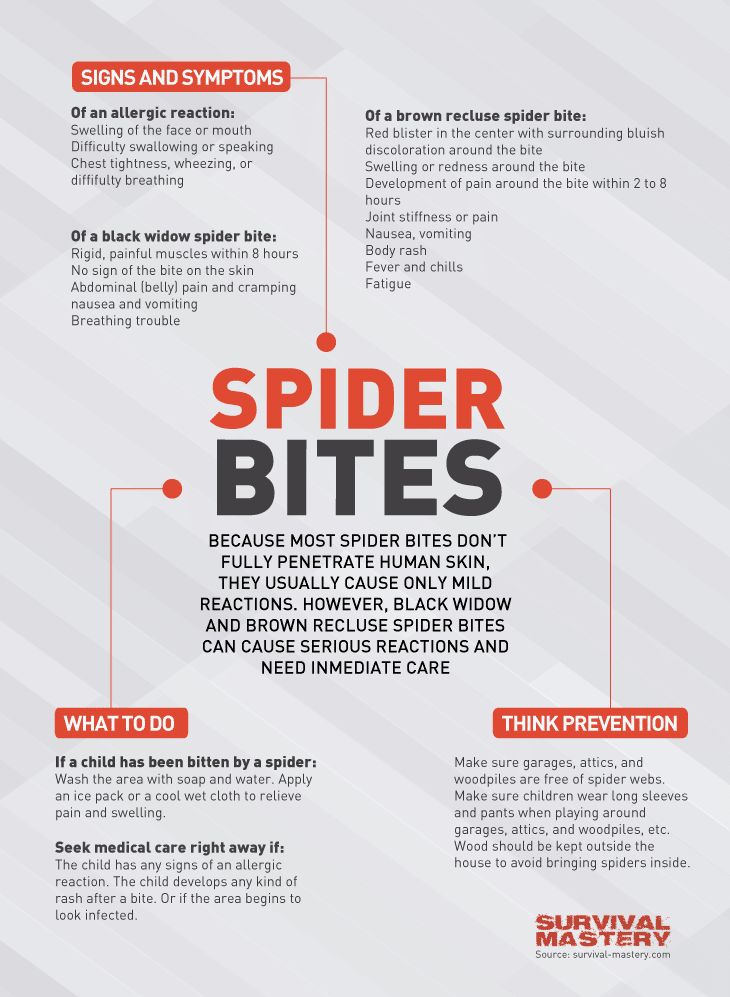
Consequences of Spider Bites: Subtle to Life-Altering
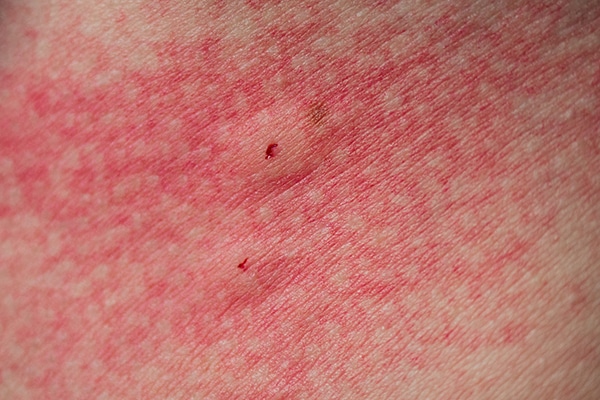
Not all spiders have a deadly bite. In fact, many have either fangs too small to harm us or poison too mild to affect us.
Symptoms from a spider bite can range from swelling at the site to fevers, coma, and death. Knowing the symptoms of a bite and what to look for can help you gauge the seriousness of the situation.
- More typical symptoms – Swelling and inflammation at the site, coupled with fevers and nausea. Severity varies with the type and location of the bite.
- Necrosis. If allowed to spread long enough, some patients lose large amounts of muscle tissue. In these cases doctors may have to remove the dead tissue, and in extreme cases even limbs.
Spiders that have neurotoxins in their poison, like the black widow, can cause lasting neurological damage, and this can be preceded by death if the poison is allowed to spread for a long period of time.
However, modern medicine and innovations in immunology have led to the development of antivenins, making it, so only a minimal number (less than 1%) of people in the US die from spider bites.
Modern Innovations in Spider Bite Treatment
Antivenom is without doubt humanity’s most reliable treatment for spider bites.
Antivenoms are produced by taking venom from the poisonous spider and introducing it to the body of a host animal, like a pig or a sheep. The animal’s body has an immune response to the poison, which triggers the production of antibodies. The antibodies are then harvested to produce the antivenom.
Antivenoms are administered by medical professionals in the event of a venomous spider bite via intravenous injection. The antivenom binds to the venom itself, neutralizing the toxin and stopping further damage.
However, the injection of antivenom will not undo the necrosis caused by the poison. This is why it’s so important to get to the hospital at the first sign of a poisonous spider bite.
Spider Bite Treatment – Final Thoughts
Arachnids are a beautiful and no doubt necessary part of nature’s design. Gardeners, in particular, welcome their presence and help in managing pest populations that prey on their produce.
In addition, as diseases spread through mosquito bites ever more rapidly, we can look to the food chain and the spider’s role in maintaining balance with these insects.
However, some species can be aggressive and deadly. Therefore, it’s important to familiarize yourself with the physical characteristics of the more dangerous species so that you can take measures to protect yourself and your family.
Know the signs and symptoms of a bite, and have a first aid kit at the ready to treat the bites as quickly as possible.
If you think you have a spider bite and you have the communication needed, contact your doctor immediately.






Salt is another simple cure because of its clean and calming properties. It can successfully draw the venom out from a spider bite moreover, it decreases irritation and redness.
1. Wash the influenced territory thoroughly with tepid water.
2. Sprinkle some table salt on a wet washcloth. (You can also utilize genuine or ocean salt.)
3. Swathe this washcloth to the influenced part for two or three hours, then expel it.
4. Reapply as required.
Wayne,
Thank you for this tip. Salt has many curing properties and this is one of them. There are other ways to draw out the venom and I suggest reading up on this topic if you want a more detailed insight.
Nora
Very informative! I also would like to add that you can apply an ice pack to a bite for 15 minutes (but no longer than 20 minutes) once an hour for 6 hours. When not using ice, keep a cool, wet cloth on the bite up to 6 hours. Always keep a cloth between your skin and ice pack. You can also take antihistamine orally (for children, consult a doctor first before administering) just like what is written above to relieve the redness and swelling. Tylenol or other Acetaminophen medicines can lower your fever and pain. Hope it helps too :)
Ice packs are a nice touch to prevent inflammation but I would be careful in doling out medicines, especially for children. The best way to go is to proceed to a medical facility right after first aid is applied.
An interesting article to read. Spiders have different amounts of venom that they can inject to your skin, the safest way of knowing if the bite has venom is to go to a doctor immediately especially when you didn’t see the spider that bit you.
As you are heading to the doctor: apply an ice pack to the bite, elevate the bitten area to reduce swelling, and try homemade remedies to manage the itching and swelling.
I do have one question though. Do you know about spiders whose venom has hallucinogenic effects? It might be hard to drive to a doctor to treat your spider bite when the venom has hallucinogens.
Spiders freak me out and knowing the dangers that they can cause is the first step of treating a spider bite. The more you know, the better you will become at handling the situation when you are bitten by spiders.
Hallucinogenic effects are rare and possibly unheard of, but the main effects are chills, nausea, fever, irritation and necrosis in the bitten area. Learn the basics of spider treatment to be on the safe side when that unfortunate day comes and you are bitten.
The very first things that you need to know about a spider bite are the symptoms and treatments, especially homemade remedies. The information provided in this article will not only educate you on spider bites and treatments, but also provide you with future reference.
Despite the numerous spider bite treatment articles that we have today, development of the said medication never stops. One of the familiar cure for brown recluse bites is TIL. On the other hand, dapsone, which is also a familiar cure is not sought to be effective by many. In most cases, bacterial cause infection might be the main reason, but people just think it is a spider bite.
My brother used to have a spider before; I just don’t know what kind it was. He loved to play with it, and I guess he has a collection of species. One day he told me that he was bitten by his beloved pet. Of course, first reaction, I ignored. Until such time, his bite came to its worst appearance. Is there any time duration for a spider bite to be treated?
Pets have a great chance of getting bitten, they are playful animals and are often found sniffing and exploring unusual places, often in those place are home to a number of insects which do not hesitate to bite. I had a dog bitten by a spider once, he was clearly showing signs of weakness and I did not know what was happening. So, I rushed to the vet, by the time we got there its heart rate had increased and he had fever, as well. The vet told me it was a spider bite, it’s good that we were fast, he could have gotten into shock.
You can avoid spider bites by cleaning your garage, attic, garden or any other place where insects tend to be. Also, wear a long-sleeved shirt, a hat, gloves and boots. Do remember to always inspect your gloves, boots and clothing if you left them unused for a long time. Keep in mind to tuck your pants and shirt into socks and gloves to minimize the chances of entry.
It is always wise to treat a spider bite as soon as possible. But you need to know the type/species of spider that bit you.
Well said, you can best prevent spider bites when going into the woods, if you wear light-colored, smooth-finished attire that cover your body, including long-sleeve shirts, long pants, and gloves.
The severities of symptoms that may present after a spider bite depend on the type of spider. In most cases, a spider bite may present minor swelling, redness, pain, and itching. However, fast response is necessary.
The best way to avoid misconceptions about spider medication (including over the counter and homemade) is to learn as much as you can about them.
The best way to avoid misconceptions about spider medication (including over the counter and homemade) is to learn as much as you can about them.